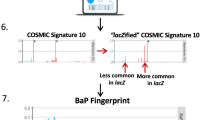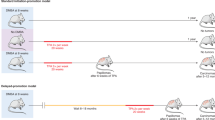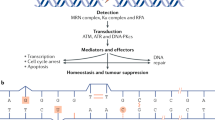Abstract
Epidemiological studies have identified many environmental agents that appear to significantly increase cancer risk in human populations. By analyzing tumor genomes from mice chronically exposed to 1 of 20 known or suspected human carcinogens, we reveal that most agents do not generate distinct mutational signatures or increase mutation burden, with most mutations, including driver mutations, resulting from tissue-specific endogenous processes. We identify signatures resulting from exposure to cobalt and vinylidene chloride and link distinct human signatures (SBS19 and SBS42) with 1,2,3-trichloropropane, a haloalkane and pollutant of drinking water, and find these and other signatures in human tumor genomes. We define the cross-species genomic landscape of tumors induced by an important compendium of agents with relevance to human health.
This is a preview of subscription content, access via your institution
Access options
Access Nature and 54 other Nature Portfolio journals
Get Nature+, our best-value online-access subscription
$29.99 / 30 days
cancel any time
Subscribe to this journal
Receive 12 print issues and online access
$209.00 per year
only $17.42 per issue
Buy this article
- Purchase on Springer Link
- Instant access to full article PDF
Prices may be subject to local taxes which are calculated during checkout





Similar content being viewed by others
Data availability
The raw sequencing data are available for download from the European Nucleotide Archive under accession nos. ERP021985 (lung tumor sequence data), ERP104478 and ERP106735 (liver tumor sequence data), ERP110807 (liver tumor methylation data), ERP106734 (kidney tumor sequence data), ERP115196 (stomach tumor sequence data). All other data are available in the supplementary tables and in the source data file. Source data are provided with this paper.
Code availability
The code used in this study is available at https://github.com/team113sanger/mouse-mutatation-signatures.
References
Alexandrov, L. B. et al. The repertoire of mutational signatures in human cancer. Nature 578, 94–101 (2020).
Alexandrov, L. B. et al. Signatures of mutational processes in human cancer. Nature 500, 415–421 (2013).
Kemp, C. J. Animal models of chemical carcinogenesis: driving breakthroughs in cancer research for 100 years. Cold Spring Harb. Protoc. 2015, 865–874 (2015).
Bucher, J. R. The National Toxicology Program rodent bioassay: designs, interpretations, and scientific contributions. Ann. N. Y. Acad. Sci. 982, 198–207 (2002).
Innes, J. R. et al. Bioassay of pesticides and industrial chemicals for tumorigenicity in mice: a preliminary note. J. Natl Cancer Inst. 42, 1101–1114 (1969).
Keane, T. M. et al. Mouse genomic variation and its effect on phenotypes and gene regulation. Nature 477, 289–294 (2011).
Maronpot, R. R. Biological basis of differential susceptibility to hepatocarcinogenesis among mouse strains. J. Toxicol. Pathol. 22, 11–33 (2009).
Ames, B. N., Durston, W. E., Yamasaki, E. & Lee, F. D. Carcinogens are mutagens: a simple test system combining liver homogenates for activation and bacteria for detection. Proc. Natl Acad. Sci. USA 70, 2281–2285 (1973).
Mimaki, S. et al. Hypermutation and unique mutational signatures of occupational cholangiocarcinoma in printing workers exposed to haloalkanes. Carcinogenesis 37, 817–826 (2016).
Alexandrov, L. B. et al. Clock-like mutational processes in human somatic cells. Nat. Genet. 47, 1402–1407 (2015).
Olivier, M. et al. Modelling mutational landscapes of human cancers in vitro. Sci. Rep. 4, 4482 (2014).
Nik-Zainal, S. et al. The genome as a record of environmental exposure. Mutagenesis 30, 763–770 (2015).
Renaud, H. J., Cui, J. Y., Khan, M. & Klaassen, C. D. Tissue distribution and gender-divergent expression of 78 cytochrome P450 mRNAs in mice. Toxicol. Sci. 124, 261–277 (2011).
Vinylidene chloride. IARC Monogr. Eval. Carcinog. Risks Hum. 71, 1163–1180 (1999).
Alexandrov, L. B. et al. Mutational signatures associated with tobacco smoking in human cancer. Science 354, 618–622 (2016).
Woodfine, K. et al. Replication timing of the human genome. Hum. Mol. Genet. 13, 191–202 (2004).
Haradhvala, N. J. et al. Mutational strand asymmetries in cancer genomes reveal mechanisms of DNA damage and repair. Cell 164, 538–549 (2016).
Stamatoyannopoulos, J. A. et al. Human mutation rate associated with DNA replication timing. Nat. Genet. 41, 393–395 (2009).
Lawrence, M. S. et al. Mutational heterogeneity in cancer and the search for new cancer-associated genes. Nature 499, 214–218 (2013).
Kazanov, M. D. et al. APOBEC-induced cancer mutations are uniquely enriched in early-replicating, gene-dense, and active chromatin regions. Cell Rep. 13, 1103–1109 (2015).
Rebhandl, S., Huemer, M., Greil, R. & Geisberger, R. AID/APOBEC deaminases and cancer. Oncoscience 2, 320–333 (2015).
Lison, D., van den Brule, S. & Van Maele-Fabry, G. Cobalt and its compounds: update on genotoxic and carcinogenic activities. Crit. Rev. Toxicol. 48, 522–539 (2018).
Bailey, M. H. et al. Comprehensive characterization of cancer driver genes and mutations. Cell 173, 371–385.e18 (2018).
Huang, X., Wojtowicz, D. & Przytycka, T. M. Detecting presence of mutational signatures in cancer with confidence. Bioinformatics 34, 330–337 (2018).
Kucab, J. E. et al. A compendium of mutational signatures of environmental agents. Cell 177, 821–836.e16 (2019).
Li, H. Toward better understanding of artifacts in variant calling from high-coverage samples. Bioinformatics 30, 2843–2851 (2014).
Jones, D. et al. cgpCaVEManWrapper: simple execution of CaVEMan in order to detect somatic single nucleotide variants in NGS data. Curr. Protoc. Bioinformatics 56, 15.10.1–15.10.18 (2016).
Raine, K. M. et al. cgpPindel: identifying somatically acquired insertion and deletion events from paired end sequencing. Curr. Protoc. Bioinformatics 52, 15.7.1–15.7.12 (2015).
Bergstrom, E. N. et al. SigProfilerMatrixGenerator: a tool for visualizing and exploring patterns of small mutational events. BMC Genomics 20, 685 (2019).
Ramazzotti, D., Lal, A., Liu, K., Tibshirani, R. & Sidow, A. De novo mutational signature discovery in tumour genomes with SparesSignatures. Preprint at bioRxiv https://doi.org/10.1101/384834 (2019).
Davis, C. A. et al. The Encyclopedia of DNA elements (ENCODE): data portal update. Nucleic Acids Res. 46, D794–D801 (2018).
Morganella, S. et al. The topography of mutational processes in breast cancer genomes. Nat. Commun. 7, 11383 (2016).
Quinlan, A. R. & Hall, I. M. BEDTools: a flexible suite of utilities for comparing genomic features. Bioinformatics 26, 841–842 (2010).
Blokzijl, F., Janssen, R., van Boxtel, R. & Cuppen, E. MutationalPatterns: comprehensive genome-wide analysis of mutational processes. Genome Med. 10, 33 (2018).
Tate, J. G. et al. COSMIC: the Catalogue of Somatic Mutations in Cancer. Nucleic Acids Res. 47, D941–D947 (2019).
Oesper, L., Satas, G. & Raphael, B. J. Quantifying tumor heterogeneity in whole-genome and whole-exome sequencing data. Bioinformatics 30, 3532–3540 (2014).
Acknowledgements
This work was funded by grants to D.J.A. from the Wellcome Trust, Cancer Research UK (with A.B.), the CRUK-funded Mutographs Project Work Package 3 (to A.B.) and the European Research Council under the European Union’s Seventh Framework Programme (no. FP7/2007–2013)/ERC synergy grant agreement no. 319661 COMBATCANCER. A.B. acknowledges support from National Cancer Institute grant no. R35CA210018. A.D. is supported by a UKRI Fellowship (no. MR/S00386X/1). We acknowledge the ENCODE Consortium and the ENCODE production laboratories. We acknowledge the support provided by the staff at the NTP tissue archives for this study. We thank M. Stratton, A. Boot, S. Rozen, S. Jackson and D. Phillips for helpful discussions.
Author information
Authors and Affiliations
Contributions
The study was conceived by A.B. and R.C.S. R.C.S., A.B. and D.J.A. designed and supervised the project. Tumors were collected/generated by A.R.P., R.A.H., R.C.S. and the NTP. Computational analyses were performed by L.R., Y.R.L., A.D., M.A.Q., P.J.C., V.I., R.S. and L.B.A. Histopathology evaluation and sequencing were performed by A.R.P. and J.H., respectively. The manuscript was written by L.R. and D.J.A. with contributions from all other authors.
Corresponding authors
Ethics declarations
Competing interests
The authors declare no competing interests.
Additional information
Publisher’s note Springer Nature remains neutral with regard to jurisdictional claims in published maps and institutional affiliations.
Extended data
Extended Data Fig. 1 The comparative landscape of spontaneous and chemically induced tumours with genomic features.
a, Comparison of the colocalization of substitutions with histone marks and open chromatin in spontaneous and chemically induced tumours. Each point is a single replicate (for the induced these points are aggregated across multiple chemicals). For each point, we plot the observed/expected data from the MutationalPatterns software. The box plots show the Tukey statistics: The box shows the 1st—3rd quartiles, with a line at the median. The whiskers extend from the 1st and 3rd quartiles to the largest value no more than 1.5*IQR from the relevant quartile (See Source Data for sample numbers in each comparison). b, Table reporting the adjusted P values for the comparisons in a. A two-sided Mann-Whitney U-test was used to calculate the false-discovery rate corrected P values. c, Signatures identified using sigProfiler in the pentanucleotide context.
Extended Data Fig. 2 Strand coordinated clustering along the genome.
a, a liver tumour from a mouse exposed to TCP and b, a lung tumour from a mouse exposed to Isobutyl Nitrite.
Extended Data Fig. 3 Hierarchical clustering of the contribution of mSBS signatures across the collection of lung, liver, kidney and forestomach tumours sequenced in this study.
The profile of mutational signatures across the tumour collection. The signature profiles are shown in Fig. 1.
Extended Data Fig. 4 The landscape of Mouse Doublet Base Substitution (mDBS) Signatures induced by chemical exposures and endogenous mutagenic processes.
a, The catalogue of mouse doublet base substitution (mDBS) signatures. mDBS_N1 and mDBS_N2 are new DBS signatures. b, Number of mutations for each mDBS signature across the collection of lung, liver, kidney and forestomach tumours. Component 0 accounts for very few mutations and represents background mutations. c, The DBS spectrum obtained by normalizing and averaging the DBS spectra of the six lung tumours exposed to cobalt. This profile is almost identical to mDBS_N2.
Extended Data Fig. 5 The catalogue of mouse indel substitution (mID) signatures.
Shown are the indel signatures that were computed from the whole genome sequence data generated in this study.
Extended Data Fig. 6 Hierarchical clustering of copy number variants across the tumour collection.
Copy number events were called as described in the Methods. Notable clustering for tumours from mice exposed to DE-71 and vinylidene chloride are shown. The scale indicates absolute copy number.
Extended Data Fig. 7 Structural variants in spontaneous and chemical induced tumours.
a, Structural variants of two lung tumours showing chromothripsis and two liver tumours with many inversion events. b, Structural variants in the other samples (excluding the samples in a) across the collection of lung, liver, kidney and forestomach tumours.
Extended Data Fig. 8 Comparison of signatures computed with HDP to those computed with SigProfiler with 6 components (default result).
Shown are the signatures identified using HDP and corresponding signatures identified using the SigProfiler algorithm. For this comparison SigProfiler was run with 6 components.
Extended Data Fig. 9 Comparison of signatures computed with HDP to those computed with SigProfiler with 9 components.
Shown are the signatures identified using HDP and corresponding signatures identified using the SigProfiler algorithm. For this comparison SigProfiler was used with 9 components.
Supplementary information
Supplementary Tables
Supplementary Tables 1–12
Source data
Source Data Fig. 1a
Statistical source data
Source Data Fig. 3a
Statistical source data
Source Data Fig. 3c
Statistical source data
Source Data Fig. 4c
Statistical source data
Rights and permissions
About this article
Cite this article
Riva, L., Pandiri, A.R., Li, Y.R. et al. The mutational signature profile of known and suspected human carcinogens in mice. Nat Genet 52, 1189–1197 (2020). https://doi.org/10.1038/s41588-020-0692-4
Received:
Accepted:
Published:
Issue Date:
DOI: https://doi.org/10.1038/s41588-020-0692-4
This article is cited by
-
Visualizing and exploring patterns of large mutational events with SigProfilerMatrixGenerator
BMC Genomics (2023)
-
How air pollution causes lung cancer — without harming DNA
Nature (2023)
-
Air pollution’s role in the promotion of lung cancer
Nature (2023)
-
Arsenic is a potent co-mutagen of ultraviolet light
Communications Biology (2023)
-
DNA damage and somatic mutations in mammalian cells after irradiation with a nail polish dryer
Nature Communications (2023)



